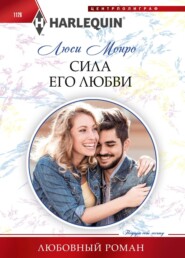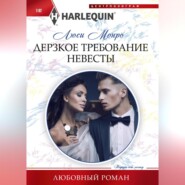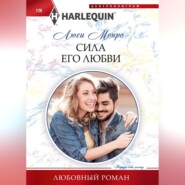По всем вопросам обращайтесь на: info@litportal.ru
(©) 2003-2025.
✖
The Desert Sheikh's Innocent Queen: King of the Desert, Captive Bride
Автор
Год написания книги
2019
Настройки чтения
Размер шрифта
Высота строк
Поля
“It’s not just a ring,” the Egyptian jeweler said soberly, “it’s a symbol of your commitment, and you’ll want a ring that will always remind you of your love and vows—”
“Khalid,” Liv murmured, rising to her feet. “May I please have a word with you?”
“Of course,” he answered, “but we can speak freely here. Mr. Murai is an old friend of my family’s and has been in the jewelry business a long time. You are not the first jittery bride-to-be he has helped.”
Liv’s frustration grew. Khalid was deliberately misunderstanding her. “I’m just overwhelmed,” she said. “I don’t think I can make this decision today. Perhaps at the end of the week …?”
“I want my ring on your finger,” Khalid answered bluntly. “It’s important to me. It’s important to my people, and it’s important to my family.”
“But I don’t know anything about diamonds or jewels—”
“Which is why Mr. Murai is here. He’s not just the best in Cairo, he’s one of the best jewelers in the world. Most of the royal families use him.”
But she didn’t want to wear a ring, especially not a ring like this. None of these was just a simple band, but a statement of wealth, a statement of style and lifestyle—all things Liv wasn’t comfortable with.
“I understand you want me to wear a ring,” she said, swallowing with difficulty, “but these rings are too much. They’re so elaborate, and large and more than I need.”
“Miss Morse, I understand this can be overwhelming,” Mr. Murai said kindly. “Selecting one’s ring is often a very emotional decision and it requires time and thought. Please, won’t you sit down again and tell me a little about what you’d like? There’s no hurry, no pressure. We shall take as much time as you need, we will try every ring, and if nothing pleases you, I shall go, search out more beautiful choices and bring them back to you.”
Liv looked up at Khalid as the jeweler spoke and she stared at him hard, wanting to tell him that she still wasn’t happy even as she knew that Khalid would have his way.
She couldn’t fight with Khalid in front of the jeweler. Khalid had said appearances mattered. He said everything they did would be scrutinized, including her wardrobe, her jewelry, and what she wore—or didn’t wear—on her ring finger.
Slowly she sat back down on the couch. “I don’t know very much about diamonds,” she said, her voice pitched low.
“That’s fine, I can teach you what I know.”
She nodded, aware of Khalid standing behind the jeweler, aware that he’d hardly glanced at the case of jewels. Instead his entire focus seemed to rest on her.
“Do you have any favorite pieces at home?” the jeweler persisted.
She blushed shyly. “I don’t own very much jewelry, just an opal ring my brother’s former girlfriend brought me back from Australia, and a pearl necklace my father gave me when I turned eighteen.”
“No diamonds?” the jeweler asked.
“No diamonds.”
“Well, then, we will make sure your first is exactly right for you.” Mr. Murai gestured to the front row of diamonds. “I don’t know if diamonds are truly a girl’s best friend, but I do know diamonds are timeless. The popularity of the cut might come and go, but the stone itself remains the most popular of all gemstones.
“There are three very popular cuts at the moment,” he continued. “The marquise, rose and cushion. All the rings in this front row are one of those cuts. As you can see,” he said, lifting one of the rings and tilting it to catch the light, “the marquise cut is boat-shaped, pointed at both ends and one of the most popular cuts today although it dates back to the 1700s.”
She watched him tip the ring this way and that, amazed at how the ring glowed all the way through, glinting with bits of fire and light. “It’s very pretty.”
He glanced up at her. “But not right for you?”
“It’s very dramatic,” she answered.
Smiling, Mr. Murai replaced the large marquise cut diamond ring and picked up another. “This is a rose cut, and the rose cut was developed in the sixteenth century. As you can see, it’s a very glamorous, very elegant look. Some people think it’s classic Hollywood, others see it and think of the crown jewels. You’ll notice there’s a flat base and all the facets radiate from the center.”
It was beautiful, but not her. The setting was beautiful, too, but it just felt too … old, too much like what a grandmother might wear. Not that her grandmother had ever owned a diamond bigger than a half carat.
“Not for you,” the jeweler guessed, slipping the ring back and reaching for another. “This one dates to the 1600s and it’s known as the cushion cut. Note the square or rectangular shape and the rounded corners. Many people think a diamond’s brilliance is particularly enhanced by this cut.”
“That’s gorgeous, too,” she said, but there was no way she’d ever wear a ring that big, or a stone that large. “How big a carat is that?” she asked, just out of curiosity.
“Just under twelve carats.”
“Heavens,” she choked, recoiling. “Twelve carats? Who could afford that?”
“Your fiancé,” Mr. Murai answered evenly, putting the ring back. “His brothers. Their friends.”
“I’m sorry, but I find it almost offensive—” She broke off apologetically. “I just couldn’t in good conscience ever wear something like that when I know half the world is starving. It doesn’t seem right.”
Khalid abruptly moved forward, leaned over the open briefcase and searched the trays of rings. “That one,” he said, pointing to a two-and-a-half-carat yellow pear-shaped diamond in a platinum band. Smaller diamonds sparkled at the prongs.
Mr. Murai took the ring out of the case. “One of my favorite rings,” the jeweler said, twisting it to capture the light. “Very classic, and very, very elegant.”
It was beyond beautiful, and it wasn’t something she would have ever chosen to try, but there was something in the shape and the design that captured her imagination.
“Try it on,” the jeweler encouraged.
Uncertainly Liv slid the ring onto her left hand and gazed down at the flawless diamond, the palest yellow. The ring made her skin look creamy, while the stone itself reminded her of sun and sweet, ripe fruit and lemon meringue.
She turned her hand to the light, then dropped her hand low and finally brought the ring up near her face to inspect the exquisite setting more closely.
“It suits you,” Khalid said quietly.
She looked up at him, her cheeks flushed. “It’s the most beautiful ring I’ve ever seen.”
“Is there anything else you’d like better?” he asked.
“No,” she answered breathlessly, curling her fingers, feeling the weight of the stone against the back of her finger and the smooth warm fit of the platinum band on her skin. “But it’s too much, far too much—”
“That is the ring,” Khalid said, turning to Mr. Murai. “Can we have it sized this morning and returned to us before our noon flight?”
Mr. Murai nodded. “Not a problem.”
“We’ll leave for the airport at eleven-thirty,” Khalid added.
Liv looked at him, and then back at the ring, which was still enormous at two and a half carats, and yet it was also beautiful, beyond beautiful, and she couldn’t believe it was going to be hers.
It shouldn’t be hers. She wasn’t really going to marry Khalid. She was going to go home and get back to her job and become just Liv Morse again, but until then, would it be so awful to actually wear something this lovely? God knows, she’d never have anything like this again.
Girls like her didn’t own jewels. Girls like her just admired them in magazines.
“I’ll have the ring sized immediately,” the jeweler answered, “and will personally bring it back to you.”
After Mr. Murai left with his briefcase of rings, Liv stood at the window with the view of the Great Pyramid, feeling increasingly pensive.














